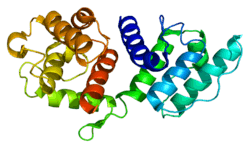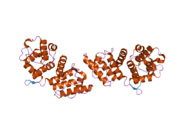Actinin alpha 3
| View/Edit Human | |||
Alpha-actinin-3, also known as alpha-actinin skeletal muscle isoform 3 or F-actin cross-linking protein, is a protein that in humans is encoded by the ACTN3 gene.[2][3]
Alpha-actinin is an actin-binding protein with multiple roles in different cell types. This gene expression is limited to skeletal muscle. It is localized to the Z-disc and analogous dense bodies, where it helps to anchor the myofibrillar actin filaments.[2]
Fast versus slow twitch muscle fibers
Skeletal muscle is composed of long cylindrical cells called muscle fibers. There are two types of muscle fibers, slow twitch or muscle contraction (type I) and fast twitch (type II). Slow twitch fibers are more efficient in using oxygen to generate energy, while fast twitch fibers are less efficient. However, fast twitch fibers fire more rapidly and generate more force. Fast twitch fibers and slow twitch fibers are also called white muscle fibers and red muscles fibers, respectively.
ACTN3 in muscle fiber
Each muscle fiber is composed of long tubes called myofibrils which in turn are composed of filaments. There are two types of filaments: actin (thin filaments) and myosin (thick filaments) which are arranged in parallel. A muscle contraction involves these filaments sliding past each other.
Actin filaments are stabilized by actin binding proteins known as actinins of which there are two main types, type 2 and type 3. Each of these is encoded by a specific gene, ACTN2 and ACTN3 respectively.
ACTN2 is expressed in all skeletal muscle fibers whereas ACTN3 is expressed only in fast twitch fibers.
rs1815739 mutation
A mutation (rs1815739; R577X) has been identified in the ACTN3 gene which results in a deficiency of alpha-actinin 3 in a significant proportion of the population.[4][5] Based on ethnicity the deficiency is found in 20-50% of people. Generally, Africans have the lowest incidence of the mutation while Asians have the highest. Scientists speculate that variations in this gene evolved to accommodate the energy expenditure requirements of people in various parts of the world.[4]:155–156
Studies have linked the fiber twitch type with ACTN3, i.e. fast twitch fiber abundant individuals carry the non-mutant gene version. Also, studies in elite athletes have shown that the ACTN3 gene may influence athletic performance. While the non-mutant version of the gene is associated with sprint performance, the mutant version is associated with endurance.[6][7][8][9][10]
Interactions
ACTN3 has been shown to interact with Actinin, alpha 2.[11]
See also
References
- ↑ "Human PubMed Reference:".
- 1 2 "Entrez Gene: ACTN3 actinin, alpha 3".
- ↑ Beggs AH, Byers TJ, Knoll JH, Boyce FM, Bruns GA, Kunkel LM (May 1992). "Cloning and characterization of two human skeletal muscle alpha-actinin genes located on chromosomes 1 and 11". J. Biol. Chem. 267 (13): 9281–8. PMID 1339456.
- 1 2 David Epstein. The Sports Gene: Inside the Science of Extraordinary Athletic Performance. ISBN 9781101622636
- ↑ North KN, Yang N, Wattanasirichaigoon D, Mills M, Easteal S, Beggs AH (April 1999). "A common nonsense mutation results in alpha-actinin-3 deficiency in the general population". Nat. Genet. 21 (4): 353–4. doi:10.1038/7675. PMID 10192379.
- ↑ Yang N, MacArthur DG, Gulbin JP, Hahn AG, Beggs AH, Easteal S, North K (September 2003). "ACTN3 genotype is associated with human elite athletic performance". Am. J. Hum. Genet. 73 (3): 627–31. doi:10.1086/377590. PMC 1180686
 . PMID 12879365.
. PMID 12879365. - ↑ Niemi AK, Majamaa K (August 2005). "Mitochondrial DNA and ACTN3 genotypes in Finnish elite endurance and sprint athletes". Eur. J. Hum. Genet. 13 (8): 965–9. doi:10.1038/sj.ejhg.5201438. PMID 15886711.
- ↑ Moran CN, Yang N, Bailey ME, Tsiokanos A, Jamurtas A, MacArthur DG, North K, Pitsiladis YP, Wilson RH (January 2007). "Association analysis of the ACTN3 R577X polymorphism and complex quantitative body composition and performance phenotypes in adolescent Greeks". Eur. J. Hum. Genet. 15 (1): 88–93. doi:10.1038/sj.ejhg.5201724. PMID 17033684.
- ↑ Roth SM, Walsh S, Liu D, Metter EJ, Ferrucci L, Hurley BF (March 2008). "The ACTN3 R577X nonsense allele is under-represented in elite-level strength athletes". Eur. J. Hum. Genet. 16 (3): 391–4. doi:10.1038/sj.ejhg.5201964. PMC 2668151
 . PMID 18043716.
. PMID 18043716. - ↑ Papadimitriou ID, Papadopoulos C, Kouvatsi A, Triantaphyllidis C (April 2008). "The ACTN3 gene in elite Greek track and field athletes". Int J Sports Med. 29 (4): 352–5. doi:10.1055/s-2007-965339. PMID 17879893.
- ↑ Chan Y, Tong HQ, Beggs AH, Kunkel LM (July 1998). "Human skeletal muscle-specific alpha-actinin-2 and -3 isoforms form homodimers and heterodimers in vitro and in vivo". Biochem. Biophys. Res. Commun. 248 (1): 134–9. doi:10.1006/bbrc.1998.8920. PMID 9675099.
External links
- Human ACTN3 genome location and ACTN3 gene details page in the UCSC Genome Browser.
Further reading
- MacArthur DG, North KN (2004). "A gene for speed? The evolution and function of alpha-actinin-3.". BioEssays. 26 (7): 786–95. doi:10.1002/bies.20061. PMID 15221860.
- Beggs AH, Byers TJ, Knoll JH, et al. (1992). "Cloning and characterization of two human skeletal muscle alpha-actinin genes located on chromosomes 1 and 11.". J. Biol. Chem. 267 (13): 9281–8. PMID 1339456.
- Yürüker B, Niggli V (1992). "Alpha-actinin and vinculin in human neutrophils: reorganization during adhesion and relation to the actin network.". J. Cell. Sci. 101. ( Pt 2): 403–14. PMID 1629252.
- Pavalko FM, LaRoche SM (1993). "Activation of human neutrophils induces an interaction between the integrin beta 2-subunit (CD18) and the actin binding protein alpha-actinin.". J. Immunol. 151 (7): 3795–807. PMID 8104223.
- Chan Y, Tong HQ, Beggs AH, Kunkel LM (1998). "Human skeletal muscle-specific alpha-actinin-2 and -3 isoforms form homodimers and heterodimers in vitro and in vivo.". Biochem. Biophys. Res. Commun. 248 (1): 134–9. doi:10.1006/bbrc.1998.8920. PMID 9675099.
- North KN, Yang N, Wattanasirichaigoon D, et al. (1999). "A common nonsense mutation results in alpha-actinin-3 deficiency in the general population.". Nat. Genet. 21 (4): 353–4. doi:10.1038/7675. PMID 10192379.
- Nikolopoulos SN, Spengler BA, Kisselbach K, et al. (2000). "The human non-muscle alpha-actinin protein encoded by the ACTN4 gene suppresses tumorigenicity of human neuroblastoma cells.". Oncogene. 19 (3): 380–6. doi:10.1038/sj.onc.1203310. PMID 10656685.
- Takada F, Vander Woude DL, Tong HQ, et al. (2001). "Myozenin: an alpha-actinin- and gamma-filamin-binding protein of skeletal muscle Z lines.". Proc. Natl. Acad. Sci. U.S.A. 98 (4): 1595–600. doi:10.1073/pnas.041609698. PMC 29302
 . PMID 11171996.
. PMID 11171996. - Bang ML, Mudry RE, McElhinny AS, et al. (2001). "Myopalladin, a novel 145-kilodalton sarcomeric protein with multiple roles in Z-disc and I-band protein assemblies.". J. Cell Biol. 153 (2): 413–27. doi:10.1083/jcb.153.2.413. PMC 2169455
 . PMID 11309420.
. PMID 11309420. - Mills M, Yang N, Weinberger R, et al. (2001). "Differential expression of the actin-binding proteins, alpha-actinin-2 and -3, in different species: implications for the evolution of functional redundancy.". Hum. Mol. Genet. 10 (13): 1335–46. doi:10.1093/hmg/10.13.1335. PMID 11440986.
- Strausberg RL, Feingold EA, Grouse LH, et al. (2003). "Generation and initial analysis of more than 15,000 full-length human and mouse cDNA sequences.". Proc. Natl. Acad. Sci. U.S.A. 99 (26): 16899–903. doi:10.1073/pnas.242603899. PMC 139241
 . PMID 12477932.
. PMID 12477932. - Burgueño J, Blake DJ, Benson MA, et al. (2003). "The adenosine A2A receptor interacts with the actin-binding protein alpha-actinin.". J. Biol. Chem. 278 (39): 37545–52. doi:10.1074/jbc.M302809200. PMID 12837758.
- Gerhard DS, Wagner L, Feingold EA, et al. (2004). "The status, quality, and expansion of the NIH full-length cDNA project: the Mammalian Gene Collection (MGC).". Genome Res. 14 (10B): 2121–7. doi:10.1101/gr.2596504. PMC 528928
 . PMID 15489334.
. PMID 15489334. - Clarkson PM, Devaney JM, Gordish-Dressman H, et al. (2005). "ACTN3 genotype is associated with increases in muscle strength in response to resistance training in women.". J. Appl. Physiol. 99 (1): 154–63. doi:10.1152/japplphysiol.01139.2004. PMID 15718405.
- Franzot G, Sjöblom B, Gautel M, Djinović Carugo K (2005). "The crystal structure of the actin binding domain from alpha-actinin in its closed conformation: structural insight into phospholipid regulation of alpha-actinin.". J. Mol. Biol. 348 (1): 151–65. doi:10.1016/j.jmb.2005.01.002. PMID 15808860.
- Clarkson PM, Hoffman EP, Zambraski E, et al. (2005). "ACTN3 and MLCK genotype associations with exertional muscle damage.". J. Appl. Physiol. 99 (2): 564–9. doi:10.1152/japplphysiol.00130.2005. PMID 15817725.
- Asanuma K, Kim K, Oh J, et al. (2005). "Synaptopodin regulates the actin-bundling activity of alpha-actinin in an isoform-specific manner.". J. Clin. Invest. 115 (5): 1188–98. doi:10.1172/JCI23371. PMC 1070637
 . PMID 15841212.
. PMID 15841212. - Niemi AK, Majamaa K (2005). "Mitochondrial DNA and ACTN3 genotypes in Finnish elite endurance and sprint athletes.". Eur. J. Hum. Genet. 13 (8): 965–9. doi:10.1038/sj.ejhg.5201438. PMID 15886711.
- Triplett JW, Pavalko FM (2006). "Disruption of alpha-actinin-integrin interactions at focal adhesions renders osteoblasts susceptible to apoptosis.". Am. J. Physiol., Cell Physiol. 291 (5): C909–21. doi:10.1152/ajpcell.00113.2006. PMID 16807302.



